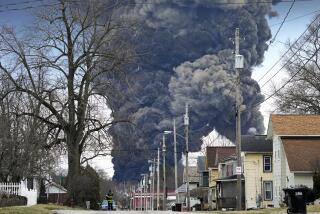The Price of Greater Rail Safety
- Share via
Seven years ago, federal officials knew about technology that could help fix a potentially fatal flaw in train braking systems. End-of-train devices, or EOTs, use a radio signal to bypass blockages in air brakes to slow a train. EOTs should have been standard equipment in all trains from the moment it was clear they could enhance rail safety.
But the Federal Railroad Administration regulators waited. And waited. Finally, last February, an emergency order was issued and railroad companies agreed to outfit their freight trains with the EOT systems. By then, much damage had been done.
Over the last 27 months alone, there have been 10 major freight train accidents. Four occurred in 1994--in California’s Cajon Pass, West Virginia, Wyoming and Colorado--and three in 1995--in Tennessee, Wisconsin and Pennsylvania. Then in February came a second derailment in the Cajon Pass, this one involving a chemical spill and fire that closed Interstate 15 between Barstow and San Bernardino, and soon afterward came accidents in Minnesota and Colorado. Total cost of the 10 accidents: more than $30 million and the deaths of five trainmen.
Perhaps some of these accidents could not have been prevented by EOT devices, but if the Federal Railroad Administration had acted sooner the speculation would have been moot. Was the cost of $5,000 per device per train prohibitive? Surely in view of the cost in lives, property and environmental damage, the answer must be no.
More to Read
Inside the business of entertainment
The Wide Shot brings you news, analysis and insights on everything from streaming wars to production — and what it all means for the future.
You may occasionally receive promotional content from the Los Angeles Times.










